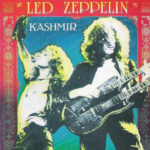 Led Zeppelin’s “Kashmir” is widely recognized as one of the band’s most ambitious and enduring masterpieces. Released in 1975 on their sixth studio album, Physical Graffiti, the song represents a pinnacle of the band’s creative vision, fusing Eastern-inspired musical motifs with hard rock power. Clocking in at over eight minutes, “Kashmir” is more than a song—it is a journey, a hypnotic odyssey that immerses listeners in a vast, cinematic soundscape. Jimmy Page’s intricate guitar work, John Bonham’s thunderous drumming, John Paul Jones’ orchestral arrangements, and Robert Plant’s impassioned vocals come together in a perfect synthesis, creating a track that feels both grounded and otherworldly.
Led Zeppelin’s “Kashmir” is widely recognized as one of the band’s most ambitious and enduring masterpieces. Released in 1975 on their sixth studio album, Physical Graffiti, the song represents a pinnacle of the band’s creative vision, fusing Eastern-inspired musical motifs with hard rock power. Clocking in at over eight minutes, “Kashmir” is more than a song—it is a journey, a hypnotic odyssey that immerses listeners in a vast, cinematic soundscape. Jimmy Page’s intricate guitar work, John Bonham’s thunderous drumming, John Paul Jones’ orchestral arrangements, and Robert Plant’s impassioned vocals come together in a perfect synthesis, creating a track that feels both grounded and otherworldly.
The allure of “Kashmir” lies in its ability to transport the listener. From the opening riff, it establishes a meditative rhythm that expands into a sprawling musical adventure. The song’s hypnotic, almost trance-like qualities make it a standout piece not just in Led Zeppelin’s catalog, but in the history of rock music itself. Its fusion of rock, blues, folk, and Eastern musical influences has made it timeless, continuing to captivate audiences across generations.
Led Zeppelin at the Height of Their Power
By the mid-1970s, Led Zeppelin had already cemented themselves as one of the most innovative and influential rock bands of the era. Their early albums, from Led Zeppelin I to Physical Graffiti, demonstrated a mastery of hard rock, blues, folk, and experimentation with unconventional structures. Physical Graffiti, in particular, was a double album showcasing the band’s musical range—from heavy, riff-driven tracks to acoustic epics and experimental instrumentals.
“Kashmir” emerged as a centerpiece of this album, embodying the band’s ambition and willingness to push boundaries. Unlike conventional rock songs of the period, which often relied on predictable verse-chorus structures, “Kashmir” embraced repetition, modal scales, and extended instrumental passages. The result was a hypnotic, immersive experience that challenged listeners while rewarding close attention.
Origins and Inspiration
Robert Plant penned the lyrics to “Kashmir” during a road trip across the deserts of Morocco, though the song itself references the northern region of Kashmir. The lyrics evoke vast landscapes, cosmic journeys, and spiritual introspection:
“Oh, let the sun beat down upon my face, stars to fill my dream
I am a traveler of both time and space, to be where I have been.”
Plant’s words capture a sense of wanderlust and awe, blending physical landscapes with metaphysical exploration. The imagery suggests both longing and transcendence, transporting listeners to distant lands while inviting introspection. The song’s lyrical themes are universal: the search for meaning, the allure of the unknown, and the human desire to connect with something larger than oneself.
Musical Composition: Hypnotic Riffs and Epic Dynamics
At the core of “Kashmir” lies Jimmy Page’s unforgettable guitar riff, constructed in a D–G–D tuning. Its repetitive, droning quality creates a mesmerizing foundation, allowing the other instruments and vocals to explore dramatic crescendos and textures. Unlike many rock riffs, which rely on speed or virtuosity, this riff derives its power from insistence and subtle harmonic shifts, creating a sense of inexorable motion.
John Paul Jones’ contributions were equally vital. His orchestral arrangements, layered keyboards, and string sections add depth and majesty, transforming a simple rock riff into a sweeping, cinematic canvas. Meanwhile, John Bonham’s drumming anchors the piece with precision and power. His use of polyrhythms, syncopation, and dynamic shifts imbues the song with a living, breathing energy, complementing the hypnotic guitar motifs.
The song’s structure is unconventional yet meticulously crafted. Repetition of the central riff, interspersed with extended instrumental sections and subtle shifts in dynamics, creates tension and release. There is no traditional chorus; instead, the song’s motifs themselves serve as hooks, drawing listeners into a meditative, immersive experience. This structural innovation contributes to the track’s enduring appeal, offering something new with each listen.
Eastern Influences and Modal Experimentation
“Kashmir” stands out for its seamless integration of Eastern musical influences. Page and Jones drew inspiration from Moroccan, Indian, and Middle Eastern scales, incorporating modal riffs and orchestral textures that evoke exotic landscapes. The modal approach, combined with Western rock instrumentation, produces a sound that is at once familiar and alien, grounding the listener in rhythm while expanding the harmonic palette.
The combination of Eastern-inspired motifs with Western rock allowed Led Zeppelin to explore uncharted musical territory. The drone-like qualities of the guitar and strings, coupled with hypnotic rhythms, give the song a transcendent quality that suggests spiritual as well as musical exploration. It is a synthesis that would influence countless rock, progressive, and experimental musicians in the decades that followed.
Vocals and Lyrics: Mysticism and Human Experience
Robert Plant’s vocals are central to the song’s impact. His performance balances power with nuance, channeling the lyrical themes of wonder, exploration, and introspection. Unlike more narrative-driven songs, “Kashmir” uses lyrics as texture, guiding the listener’s imagination rather than telling a linear story. Plant’s voice becomes an instrument in its own right, soaring above the orchestral arrangements and guitar riffs to convey both urgency and serenity.
The lyrics’ mysticism is complemented by their grounded humanity. References to time, space, and travel connect the cosmic imagery to human experience, creating a song that is both epic and intimate. Listeners can feel the vastness of the landscapes Plant evokes while simultaneously connecting with his personal journey of discovery and reflection.
Production Mastery
The production of “Kashmir” showcases Jimmy Page’s skill as both a guitarist and producer. The song’s sound is expansive, allowing each instrument to occupy its own space while contributing to a cohesive whole. The balance between guitar, strings, drums, and vocals creates a rich tapestry of sound, ensuring that the hypnotic riff remains central while the orchestration enhances the emotional and sonic depth.
The careful layering of instruments, attention to dynamic shifts, and emphasis on sonic space contribute to the track’s cinematic feel. It is a production that feels alive, breathing with the rhythms and motifs of the music, and it remains a benchmark for ambitious rock recordings.
Critical Reception and Legacy
“Kashmir” was immediately recognized as one of Led Zeppelin’s most ambitious works. Critics praised its innovation, blending of genres, and epic scope. Fans embraced it as a defining track, demonstrating the band’s ability to fuse technical mastery with emotional resonance.
Over time, “Kashmir” has only grown in stature. It is consistently cited as one of the greatest rock songs of all time and is a fixture in lists of essential Led Zeppelin tracks. Its influence extends beyond rock, inspiring musicians across genres to explore fusion, modality, and orchestration in new ways. The track’s hypnotic qualities and ambitious arrangements set a standard for what rock music could achieve in terms of scale, creativity, and emotional depth.
Live Performances: Transcendent Experiences
“Kashmir” became a centerpiece of Led Zeppelin’s live performances. On stage, the song’s hypnotic riff and dramatic arrangements translated into an immersive experience, allowing the band to expand on the studio version with improvisation and extended instrumental passages. Bonham’s drumming, in particular, elevated the live version, turning the polyrhythms and dynamics into a physical force that could be felt by the audience.
Live performances emphasized the song’s epic scope, creating communal experiences in which listeners could feel both the power of the music and the expansive landscapes it evoked. The track’s enduring presence in tribute shows and covers highlights its ability to captivate audiences even decades after its original release.
Why ‘Kashmir’ Endures
The enduring power of “Kashmir” lies in its combination of musical innovation, emotional intensity, and visionary ambition. It balances technical mastery with hypnotic simplicity, blending Eastern and Western influences, orchestral textures, and rock energy into a seamless whole. Its themes of exploration, wonder, and human connection give it depth beyond the music itself, resonating across generations.
The track’s hypnotic riff, soaring vocals, and cinematic arrangements make it an immersive experience. It is both timeless and immediate, offering listeners an adventure that transcends conventional rock boundaries. Its influence on rock, progressive, and experimental music is profound, setting a benchmark for creativity, ambition, and emotional resonance.
Conclusion: An Epic of Sound and Spirit
“Kashmir” is more than a song; it is a journey, a sonic epic that transports listeners across time, space, and imagination. It embodies Led Zeppelin at their most ambitious, blending Eastern-inspired scales, orchestral textures, hard rock power, and lyrical mysticism into a masterpiece of musical storytelling.
Its hypnotic riff, thunderous rhythm section, and Robert Plant’s soaring vocals create a track that is immersive, emotionally resonant, and unforgettable. The song stands as a testament to Led Zeppelin’s ability to transcend musical conventions, pushing the boundaries of what rock music could achieve while maintaining an emotional and spiritual core.
Decades after its release, “Kashmir” continues to captivate, inspire, and awe listeners around the world. Its epic scope, hypnotic drive, and mystical aura ensure its place as one of the greatest achievements in rock history.
“Kashmir” is the sound of distant horizons, of spiritual exploration, and of rock music at its most transcendent—a timeless masterpiece that remains as awe-inspiring today as it was in 1975.


